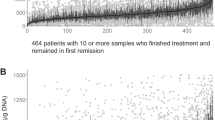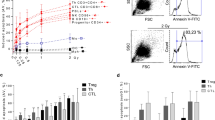Abstract
The study was designed to investigate possible relationships between tumour response and exposure to cisplatin (area under the curve of unbound cisplatin in plasma, AUC) and DNA-adduct formation in leucocytes (WBC) in patients with solid tumours. Patients were treated with six weekly courses of cisplatin at a dose of 70 or 80 mg m-2. The AUC was determined during the first course and DNA-adduct levels in WBC during all courses at baseline, 1 h (A(max)) and 15 h after a 3 h infusion of cisplatin. The area under the DNA-adduct-time curve (AUA) was calculated. The tumour response was determined after six courses. Forty-five evaluable patients received 237 courses of cisplatin. Sixteen patients with head and neck cancer received a dose of 80 mg m-2 and 29 with various other tumour types received 70 mg m-2 plus daily 50 mg oral etoposide. There were 20 responders (partial and complete) and 25 non-responders (stable and progressive disease). The AUC was highly variable (mean +/- s.d. = 2.48 +/- 0.51 micrograms h-1 ml-1; range 1.10-3.82) and was closely correlated with the AUA (r = 0.78, P < 0.0001) and A(max) (r = 0.73, P < 0.0001). The AUC, AUA and A(max) were significantly higher in responders than in non-responders in the total population (P < 0.0001) and in the two subgroups treated at 70 or 80 mg m-2. In logistic regression analysis AUC, AUA and A(max) were important predictors of response. The magnitude of exposure to cisplatin is, through DNA-adduct formation, the major determinant of the response rate in this population. Hence, individualised dosing of cisplatin using AUC or DNA-adducts should lead to increased response rates.
This is a preview of subscription content, access via your institution
Access options
Subscribe to this journal
Receive 24 print issues and online access
$259.00 per year
only $10.79 per issue
Buy this article
- Purchase on Springer Link
- Instant access to full article PDF
Prices may be subject to local taxes which are calculated during checkout
Similar content being viewed by others
Author information
Authors and Affiliations
Rights and permissions
About this article
Cite this article
Schellens, J., Ma, J., Planting, A. et al. Relationship between the exposure to cisplatin, DNA-adduct formation in leucocytes and tumour response in patients with solid tumours. Br J Cancer 73, 1569–1575 (1996). https://doi.org/10.1038/bjc.1996.296
Issue Date:
DOI: https://doi.org/10.1038/bjc.1996.296
This article is cited by
-
Systemic exposure to cisplatin and paclitaxel after intraperitoneal chemotherapy in ovarian cancer
Cancer Chemotherapy and Pharmacology (2023)
-
Population pharmacokinetics of cisplatin in small cell lung cancer patients guided with informative priors
Cancer Chemotherapy and Pharmacology (2022)
-
Optimized Dosing: The Next Step in Precision Medicine in Non-Small-Cell Lung Cancer
Drugs (2022)
-
Safety of adjuvant gemcitabine plus cisplatin chemotherapy in a patient with bilateral ureteral cancer undergoing hemodialysis
International Cancer Conference Journal (2021)
-
Chemotherapy for primary mediastinal yolk sac tumor in a patient undergoing chronic hemodialysis: a case report
Journal of Medical Case Reports (2017)



